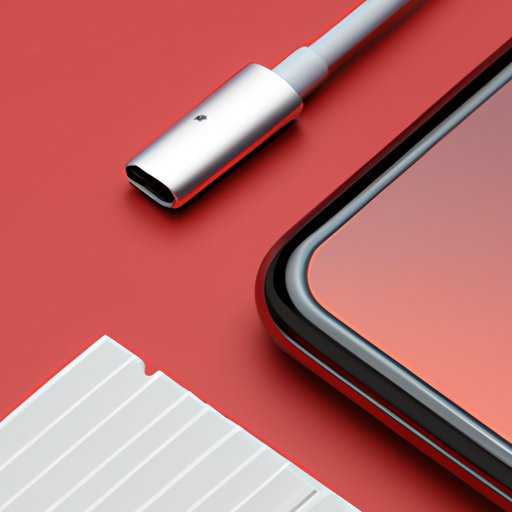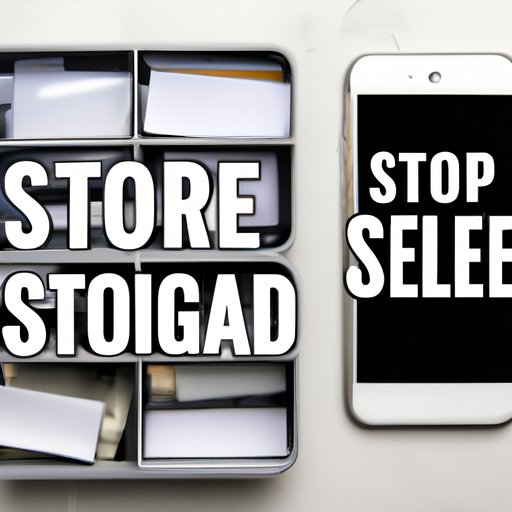
Introduction
Running out of storage space on your iPhone can be a frustrating experience. It not only limits your ability to take photos, download new apps, or install system updates but can cause performance issues on your device. In this article, we’ll explore various ways to free up space on your iPhone and improve the performance of your device.
If your iPhone storage is full, don’t worry! You don’t need to buy a new device just yet. Instead, follow the simple steps and tips outlined below.
5 Simple Steps to Free Up Space on Your iPhone
Step 1: Delete Unused Apps
Deleting unused apps can free up significant space on your iPhone. To delete an app, press and hold the app icon on the home screen. You’ll see a small “x” in the top left corner of the app icon. Tap the “x,” and then tap “Delete” to confirm. Alternatively, you can go to “Settings -> General -> iPhone Storage” to see a list of all your apps. Tap on a specific app to delete it.
Step 2: Clear Out Media Files
Photos, videos, music, and podcasts can take up a lot of space on your iPhone. Review your media files and delete any that you no longer need. You may also want to transfer them to a cloud storage service such as iCloud or Google Photos.
Step 3: Review and Delete Large Files
You may have downloaded large files such as movies or documents; these files can take up a lot of space on your device. To review the files on your device, go to “Settings -> General -> iPhone Storage -> Review Large Files.” From here, you can delete any large files that you no longer need.
Step 4: Clear Safari Cache
Clearing your Safari cache can free up some space on your iPhone. To clear your Safari cache, go to “Settings -> Safari -> Clear History and Website Data.” This will clear your browsing history, cookies, and other data on your device.
Step 5: Offload Unused Apps
The iPhone has a feature that allows you to offload unused apps, which means it removes the app itself but keeps the app’s data on your device. This way, you can always reinstall the app later without losing your app data. To offload an unused app, go to “Settings -> General -> iPhone Storage.” Choose an app you want to offload, then tap “Offload App.”

Declutter Your iPhone: Tips for Freeing Up Storage Space
Organize Your Apps
Organizing your apps can help you find what you need quickly and avoid cluttering your home screen. Rearrange your apps to make the most frequently used apps easily accessible. Use folders to group related apps, making it easier to find them later.
Use Cloud Storage Services
Using cloud storage services such as iCloud or Google Drive can be a great way to free up space on your iPhone. This way, you can store files such as photos, videos, or music in the cloud instead of on your device. You can access your files from any device with an internet connection.
Delete Unnecessary Messages and Downloads
Deleting unnecessary messages and downloads can free up space on your iPhone. Go to “Settings -> General -> iPhone Storage -> Messages” to view the space used by messages and attachments. Delete any unnecessary messages and attachments.
Delete Old Emails and Attachments
Similarly, you can delete old emails and attachments to free up storage space. Go to the Mail app and swipe left on any email you want to delete. You can also go to “Settings-> General-> iPhone Storage-> Mail” to see how much storage space is used by your email and attachments.
Manage Your Photo Library
JPEG files take up less storage space than RAW files, so if you’re running low on storage space, you may want to consider using JPEG instead of RAW. You can also limit large videos by recording in lower resolution, choosing shorter recording times, or recording videos in time-lapse mode. You can easily manage your photo library by going to “Settings -> Photos” and toggling on “iCloud Photo Library.” This will allow your images to be stored in the cloud and not take up as much space on your device.
Maximizing Your iPhone Storage: Tricks for Freeing Up Space
Enable iCloud Photo Library
Enabling iCloud Photo Library can help you store your photos and videos in the cloud. This makes it easy to access your photos and videos on any device with an internet connection, and it will help you free up space on your iPhone.
Optimize Photos and Videos Settings
You can optimize your iPhone’s photo and video settings to reduce their size, thus freeing up space on your device. You can do this by selecting “Settings -> Camera -> Formats,” and turn on “High Efficiency” to use the new High-Efficiency Image Format (HEIF) instead of JPEG and High-Efficiency Video Codec (HEVC) instead of H.264 for videos.
Use iTunes for Managed Storage
You can manage your iPhone storage manually using iTunes. Connect your iPhone to your computer and open iTunes. Click on your iPhone icon, then click on “Summary -> Photos.” From here, you can select “Sync Photos” and choose a specific folder on your computer to sync with your iPhone. This way, you can keep a backup of your photos without taking up space on your device.
Use Third-Party Apps to Manage Storage
There are many third-party apps that can help you manage your iPhone storage. Some popular apps include iMazing, PhoneClean, and iMyfone Umate. These apps can help you free up space by removing junk files, deleting unused apps, and managing your photo library.
Limit Offline Music Downloads
If you use Apple Music or another streaming music service, you can limit the amount of music downloaded to your device. Go to “Settings -> Music” and toggle off “Automatic Downloads.” You can also go to “Settings -> Music -> Cellular Data” and toggle off “Downloads” to limit downloads to Wi-Fi only.
Clearing iPhone Storage: Easy Ways to Free Up Space Quickly
Use the ‘Offload Unused Apps’ Feature
The “Offload Unused Apps” feature mentioned earlier can be a quick and easy way to free up space on your iPhone without deleting apps permanently. Go to “Settings -> General -> iPhone Storage -> Offload Unused Apps,” and turn on the feature to automatically remove unused apps and keep your device storage optimized.
Clearing App Cache and Data
Clearing your app cache and data can free up space on your iPhone. Go to “Settings -> General -> iPhone Storage,” scroll down to view the list of apps, and select an app you want to clear cache and data for. Tap on “Offload App” to delete the app and its data.
Delete Media Files from Messages
If you frequently send and receive media files such as photos, videos, and GIFs through messaging apps, these files can take up a significant amount of space on your iPhone. Go to “Settings -> General -> iPhone Storage -> Messages,” and select “Review Large Attachments” to view the space used by media files in your messaging apps.
Delete Old iMessage Data and Attachments
Similar to email, old iMessage data and attachments can take up a lot of space on your device. Go to “Settings -> General -> iPhone Storage -> Messages,” tap on “Messages,” scroll down, and toggle on “Auto-Delete Old Conversations.” This will automatically delete old conversations after a certain period, freeing up space on your iPhone.
Review and Delete Recently Deleted Files
Your iPhone has a “Recently Deleted” folder where all your deleted files are stored for 30 days before they’re permanently deleted. Go to “Photos -> Albums -> Recently Deleted” to view and permanently delete any files you no longer need.
Solutions for Running Out of Space on Your iPhone
Consider Upgrading to a Higher Storage Capacity iPhone
If you frequently run out of storage space or need to store large files, you may want to consider upgrading to a higher storage capacity iPhone. The latest iPhones come with up to 1TB of storage space, which should be sufficient for most users.
Use Intelligent Cloud Services
Intelligent cloud services such as iCloud and Google Drive can help you automatically back up your data and content to the cloud. This way, you can access your files on any device with an internet connection and free up storage space on your iPhone.
Monitor Your Storage Space Regularly
Keeping an eye on your storage space regularly can help you avoid running out of space, and it can also help you detect any apps or files that are taking up significant space on your device.
Use Third-Party Applications
Third-party applications such as CleanMyiPhone or PhoneClean can help you keep an eye on your device’s storage space and help you optimize it. They can also suggest certain apps and files that can be cleared out to free up space on your device.
How to Free Up iPhone Storage: Tips to Improve Device Performance
Update Your iPhone Software
Keeping your iPhone software up to date can help improve its performance, fix software bugs and security vulnerabilities, and free up valuable storage space. Go to “Settings -> General -> Software Update” to check if there is any available update for your iPhone.
Disable Background App Refresh
Background App Refresh is a setting that allows apps to refresh their content in the background when you’re not using them. While helpful, this feature can consume battery and data, and also take up valuable storage space on your device. Go to “Settings -> General -> Background App Refresh” and turn off the feature for specific apps or for all apps.
Control Location Services
Location Services allow apps to access your device’s GPS, and it can take up valuable storage space. Go to “Settings -> Privacy,” and toggle off the Location Services for any app or system service you don’t need.
Turn Off Automatic Downloads
Automatic Downloads allow apps and music to automatically download to your device when purchased on another device. Go to “Settings -> App Store” and turn off the feature for specific items or for all.
Manage Your Contacts and Calendars
Your Contacts and Calendars can take up valuable space on your device. If you don’t need all of them, consider syncing them to iCloud instead. You can do this by going to “Settings -> iCloud” and toggling on Contacts and Calendars syncing.
Conclusion
In conclusion, running out of space on your iPhone is a common issue that can be frustrating but can also be easily resolved using the different solutions discussed in this article. Remember, there are both simple steps you can follow, as well as more advanced tricks you can employ, to free up space on your device. Try these different solutions regularly to ensure your device runs efficiently, and you always have enough storage space for your daily needs.




